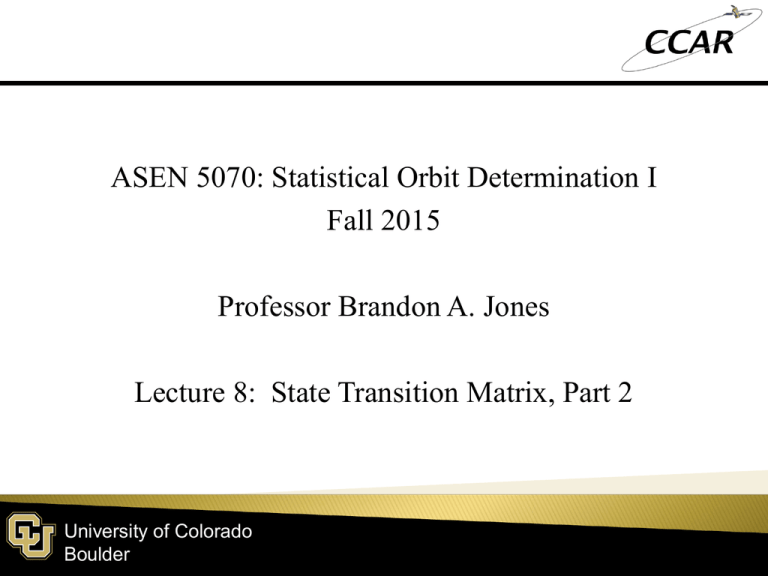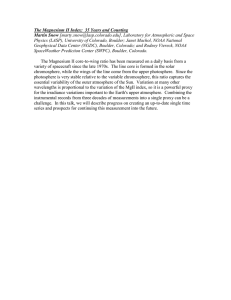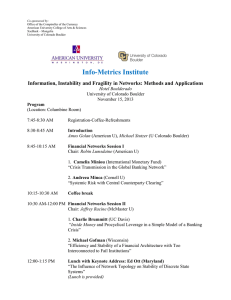ASEN 5070: Statistical Orbit Determination I Fall 2015 Professor Brandon A. Jones
advertisement

ASEN 5070: Statistical Orbit Determination I Fall 2015 Professor Brandon A. Jones Lecture 8: State Transition Matrix, Part 2 University of Colorado Boulder Homework 3 – Due Friday Sept. 18 ◦ Image files okay as long as they are legible Lecture Quiz 2 Due Today @ 5pm Lecture Quiz 3 Posted by Monday Lecture Future Lectures ◦ ◦ ◦ ◦ Lecture Lecture Lecture Lecture 9 – Monday 9/14 @ 9am 10 – Monday 9/14 @ 4pm 11 – Monday 9/21 @ 9am 12 – Monday 9/21 @ 4pm University of Colorado Boulder 2 State Transition Matrix – Part 2 University of Colorado Boulder 3 Since x is linear (note lower case!) then there exists a solution to the linear, first order system of differential equations: The solution is of the form: Φ(t,ti) is the state transition matrix (STM) that maps x(ti) to the state x(t) at time t. University of Colorado Boulder 4 Constant! What is the differential equation? University of Colorado Boulder 5 There are four methods to generate the STM: ◦ Solve from the direct Taylor expansion ◦ If A is constant, use the Laplace Transform or eigenvector/value analysis ◦ Analytically integrate the differential equation directly ◦ Numerically integrate the equations (ode45) University of Colorado Boulder 6 University of Colorado Boulder 7 University of Colorado Boulder 8 State Transition Matrix – Laplace Transform University of Colorado Boulder 9 Laplace Transforms are useful for analysis of linear time-invariant systems: ◦ ◦ ◦ ◦ ◦ electrical circuits, harmonic oscillators, optical devices, mechanical systems, even some orbit problems. Transformation from the time domain into the Laplace domain. Inverse Laplace Transform converts the system back. University of Colorado Boulder 10 University of Colorado Boulder 11 Solve the ODE We can solve this using “traditional” calculus: University of Colorado Boulder 12 Solve the ODE Or, we can solve this using Laplace Transforms: University of Colorado Boulder 13 Solve the ODE: University of Colorado Boulder 14 University of Colorado Boulder 15 University of Colorado Boulder 16 State Transition Matrix – Analytic Approach University of Colorado Boulder 17 Leverage the differential equation and combine it with classic methods Compatible with simple equations, but not with larger estimated state vectors or complicated dynamics University of Colorado Boulder 18 University of Colorado Boulder 19 University of Colorado Boulder 20 University of Colorado Boulder 21 University of Colorado Boulder 22 University of Colorado Boulder 23 University of Colorado Boulder 24 State Transition Matrix – Numeric Solution University of Colorado Boulder 25 For more complicated dynamics, must integrate X*(t) and Φ(t,t0) simultaneously in propagator ◦ Up to n+n2 propagated states ◦ Derivative function must include the evaluation of the A(t) matrix in addition to F(X,t) University of Colorado Boulder 26 Use the MATLAB reshape() command to turn matrix into a vector ◦ v = reshape( V, nrows*ncols, 1 ); MATLAB Example… University of Colorado Boulder 27


